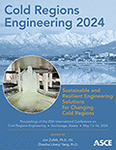Preliminary Numerical Analysis of the Impact of Heterogeneity on Seepage in Frozen Soils
Publication: Cold Regions Engineering 2024: Sustainable and Resilient Engineering Solutions for Changing Cold Regions
ABSTRACT
A standard practice in seepage analyses for mining dams with frozen components is to apply homogeneous hydraulic properties, although soil is inherently heterogeneous. In this study, a basic numerical model was developed to evaluate the impact of soil heterogeneity on seepage analyses. Sixteen combinations of soil type and heterogeneity distributions at 12 sub-zero temperatures ranging from −0.1°C to −5°C were analysed. The results of the heterogeneous cases are compared to a reference case considering equivalent homogeneous conditions. The findings suggest that homogeneous cases generally underestimate seepage and preferential water flow compared to heterogeneous cases. This research is a first step in evaluating shortcomings of the current engineering practice when modelling frozen soil water flow.
Get full access to this chapter
View all available purchase options and get full access to this chapter.
REFERENCES
Andersland, O. B., and B. Ladanyi (2004). Frozen Ground Engineering, 2nd ed. Wiley ; ASCE, Hoboken, NJ : [Reston, VA].
Blight, G. E. (2009). Geotechnical Engineering for Mine Waste Storage Facilities. CRC Press, Leiden, South Holland, Netherlands.
Chamberlain, E. J., and A. J. Gow. (1979). “Effect of Freezing and Thawing on the Permeability and Structure of Soils”, Engineering Geology, Vol. 13, pp. 73–92.
Elkateb, T., R. Chalaturnyk, and P. K. Robertson. (2003). “An overview of soil heterogeneity: quantification and implications on geotechnical field problems.” Can. Geotech. J., 40 (1): 1–15.
Ellithy, G. S. (2017). Spreadsheet for estimating soil water characteristic curves (SWCC). Report. Geotechnical and Structures Laboratory (U.S.).
Fell, R., P. MacGregor, D. Stapledon, G. Bell, and M. Foster. (2014). Geotechnical Engineering of Dams (2nd ed.), CRC Press, Leiden, Netherlands.
Fredlund, D. G. (2002). “Use of the soil-water characteristic curve in the implementation of unsaturated soil mechanics,” UNSAT 2002, Proceedings, Third International Conference on Unsaturated Soils, Recife, Brazil, March 10-13, 3: pp.
Fredlund, D. G., H. Rahardjo, and M. D. Fredlund. (2012). Unsaturated Soil Mechanics in Engineering Practice, John Wiley & Sons, Hoboken, New Jersey, United States of America.
Fredlund, D. G., A. Xing, and S. Huang. (1994). “Predicting the permeability function for unsaturated soils using the soil-water characteristic curve.” Can. Geotech. J., 31 (4): 533–546.
GEOSLOPE International Ltd. (2017). Heat and mass transfer modeling with GeoStudio 2018 (Second Edition). Calgary, Alberta, Canada.
Gitirana, G. (2005). “Weather-related Geo-hazard Assessment Model for Railway Embankment Stability.” University of Saskatchewan, Saskatchewan, Canada.
Kurylyk, B. L., and K. Watanabe. (2013). “The mathematical representation of freezing and thawing processes in variably-saturated, non-deformable soils.” Adv. Water Resour., 60: 160–177.
Northern Engineering Services Company Limited. (1975). Geotechnical Data Report Proposed Arctic Gas Pipeline - Cross Delta Alternative Route - Channel Depth Anomaly - Drilling and Sampling Program. Mackenzie Delta.
Northern Engineering Services Company Limited. (1977). Laboratory Testing Program For Thaw-Slope Stability - Discontinuous Permafrost Zone. Mackenzie River Valley.
Picard, Z., S. Dumais, and É. Devoie. (2023). “Hydraulic conductivity assessment of mining dams with frozen components.” Proc. 76th Can. Geotech. Conf. Saskatoon, Canada.
Qin, T., M. Lebeau, and J.-M. Konrad. (2013). “Influence of heterogeneity on the hydro-thermal response of an embankment dam”. Proc. 66th Can. Geotech. Conf. Montréal, Canada.
Sayles, F. H. (1987). Embankment dams on permafrost: design and performance summary, bibliography, and an annotated bibliography. US Army Cold Regions Research & Engineering Laboratory.
Smith, M., and J.-M. Konrad. (1999). “Influence of seepage on the temperature distribution in a zoned earth dam.” Field Measurements of Geomechanics, 339–343.
Watanabe, K., and Y. Osada. (2016). “Comparison of Hydraulic Conductivity in Frozen Saturated and Unfrozen Unsaturated Soils.” Vadose Zone J., 15 (5): 1–7.
Williams, P. J., and M. W. Smith. (1989). The Frozen Earth: Fundamentals of Geocryology. Studies in Polar Research. Cambridge: Cambridge University Press.
Information & Authors
Information
Published In
History
Published online: May 9, 2024
ASCE Technical Topics:
- Analysis (by type)
- Chemical properties
- Chemistry
- Engineering fundamentals
- Environmental engineering
- Frozen soils
- Geomechanics
- Geotechnical engineering
- Heterogeneity
- Homogeneity
- Material mechanics
- Material properties
- Materials engineering
- Numerical analysis
- Seepage
- Soil analysis
- Soil mechanics
- Soil properties
- Soils (by type)
Authors
Metrics & Citations
Metrics
Citations
Download citation
If you have the appropriate software installed, you can download article citation data to the citation manager of your choice. Simply select your manager software from the list below and click Download.
